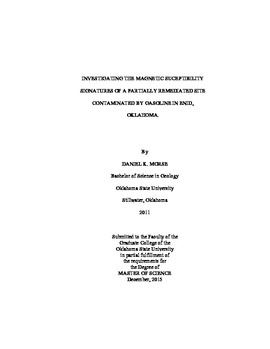| dc.contributor.advisor | Atekwana, Estella A. | |
| dc.contributor.author | Morse, Daniel K. | |
| dc.date.accessioned | 2017-02-22T22:12:55Z | |
| dc.date.available | 2017-02-22T22:12:55Z | |
| dc.date.issued | 2015-12-01 | |
| dc.identifier.uri | https://hdl.handle.net/11244/49000 | |
| dc.description.abstract | Magnetic susceptibility measurements have been traditionally used in paleoclimate studies, as a tool for oil exploration, and for mapping heavy metal contaminated soils. Recently, it has been suggested that magnetic susceptibility can be used as a tool for investigating hydrocarbon contaminated sites where iron reduction is the dominant terminal electron process. Here the dominant magnetic mineral, typically magnetite forms as a secondary byproduct of iron reduction. Therefore magnetic susceptibility can be used as a proxy for assessing locations where iron reducing microbially mediated remediation is occurring. This study extends the work of previous authors and investigates the variability of magnetic susceptibility at a hydrocarbon contaminated site in Enid, OK. Here a leaky underground storage tank resulted in the release of gasoline into the subsurface aquifer. The objectives of this study are to: (1) investigate the relationship between magnetic susceptibility and the water table fluctuation zone and (2) determine the relationship between the magnetic susceptibility variation and the contaminant phase (free, dissolved, and vapor phase) distribution. Magnetic susceptibility and electrical resistivity were measured along 3 contaminated cores retrieved from the study site. In addition, magnetic susceptibility data were acquired down 20 boreholes within contaminated and uncontaminated locations. Water samples were also retrieved for geochemical analyses to test for the presence of terminal electron acceptors indicative of biodegration. Geochemical measurements suggest that nitrate and iron reduction was the dominant terminal electron acceptor process ongoing at the site. In addition, we observed that magnetic susceptibility measurements were elevated within contaminated areas; and highest within the water table fluctuation zone, with peaks associated with the highest water level tapering down across this zone. Unlike other studies, the magnetic susceptibility measurements were not directly correlative to plume thickness, but coincides with the steepest hydrologic gradients. This observation suggests that magnetite is favorably produced along steep hydrologic and redox gradients. We conclude that magnetic susceptibility is a viable geophysical tool for investigating hydrocarbon contaminated sites, especially where steep hydrologic and redox gradients exist. | |
| dc.format | application/pdf | |
| dc.language | en_US | |
| dc.rights | Copyright is held by the author who has granted the Oklahoma State University Library the non-exclusive right to share this material in its institutional repository. Contact Digital Library Services at lib-dls@okstate.edu or 405-744-9161 for the permission policy on the use, reproduction or distribution of this material. | |
| dc.title | Investigating the Magnetic Signatures of a Partially Remediated Site Contaminated by Gasoline in Enid, Oklahoma | |
| dc.contributor.committeeMember | Halihan, Todd | |
| dc.contributor.committeeMember | Puckette, Jim | |
| osu.filename | Morse_okstate_0664M_14464.pdf | |
| osu.accesstype | Open Access | |
| dc.description.department | Geology | |
| dc.type.genre | Thesis | |
| dc.type.material | text | |
